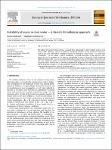Instability of waves in deep water — A discrete Hamiltonian approach
| dc.contributor.author | Andrade, D | |
| dc.contributor.author | Stuhlmeier, R | |
| dc.date.accessioned | 2023-08-01T10:13:56Z | |
| dc.date.available | 2023-08-01T10:13:56Z | |
| dc.date.issued | 2023-09 | |
| dc.identifier.issn | 0997-7546 | |
| dc.identifier.issn | 1873-7390 | |
| dc.identifier.uri | https://pearl.plymouth.ac.uk/handle/10026.1/21116 | |
| dc.description.abstract |
The stability of waves in deep water has classically been approached via linear stability analysis, with various model equations, such as the nonlinear Schrödinger equation, serving as points of departure. Some of the most well-studied instabilities involve the interaction of four waves – so called Type I instabilities – or five waves – Type II instabilities. A unified description of four and five wave interaction can be provided by the reduced Hamiltonian derived by Krasitskii (1994). Exploiting additional conservation laws, the discretised Hamiltonian may be used to shed light on these four and five wave instabilities without restrictions on spectral bandwidth. We derive equivalent autonomous, planar dynamical systems which allow for straightforward insight into the emergence of instability and the long time dynamics. They also yield new steady-state solutions, as well as discrete breathers associated with heteroclinic orbits in the phase space. | |
| dc.format.extent | 320-336 | |
| dc.language | en | |
| dc.publisher | Elsevier BV | |
| dc.subject | Water waves | |
| dc.subject | Wave-wave interaction | |
| dc.subject | Weakly-nonlinear surface waves | |
| dc.subject | Instability | |
| dc.subject | Hamiltonian systems | |
| dc.title | Instability of waves in deep water — A discrete Hamiltonian approach | |
| dc.type | journal-article | |
| dc.type | Article | |
| plymouth.author-url | https://www.webofscience.com/api/gateway?GWVersion=2&SrcApp=PARTNER_APP&SrcAuth=LinksAMR&KeyUT=WOS:001055693300001&DestLinkType=FullRecord&DestApp=ALL_WOS&UsrCustomerID=11bb513d99f797142bcfeffcc58ea008 | |
| plymouth.volume | 101 | |
| plymouth.publication-status | Published | |
| plymouth.journal | European Journal of Mechanics - B/Fluids | |
| dc.identifier.doi | 10.1016/j.euromechflu.2023.06.008 | |
| plymouth.organisational-group | |Plymouth | |
| plymouth.organisational-group | |Plymouth|Faculty of Science and Engineering | |
| plymouth.organisational-group | |Plymouth|Faculty of Science and Engineering|School of Engineering, Computing and Mathematics | |
| plymouth.organisational-group | |Plymouth|REF 2021 Researchers by UoA | |
| plymouth.organisational-group | |Plymouth|Users by role | |
| plymouth.organisational-group | |Plymouth|Users by role|Academics | |
| plymouth.organisational-group | |Plymouth|REF 2021 Researchers by UoA|UoA10 Mathematical Sciences | |
| plymouth.organisational-group | |Plymouth|REF 2021 Researchers by UoA|ZZZ Extended UoA 10 - Mathematical Sciences | |
| plymouth.organisational-group | |Plymouth|Users by role|Researchers in ResearchFish submission | |
| dcterms.dateAccepted | 2023-06-28 | |
| dc.date.updated | 2023-08-01T10:13:47Z | |
| dc.rights.embargodate | 2023-8-2 | |
| dc.identifier.eissn | 1873-7390 | |
| dc.rights.embargoperiod | forever | |
| rioxxterms.versionofrecord | 10.1016/j.euromechflu.2023.06.008 |


